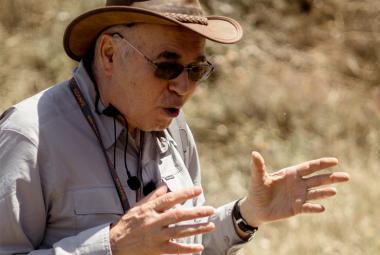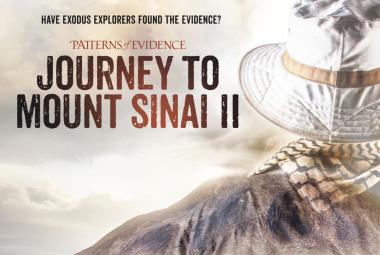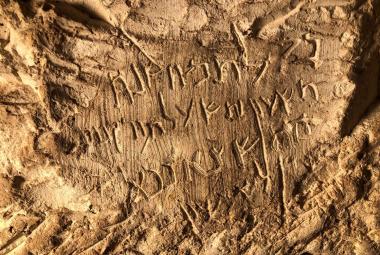In our previous article we explored some hints, in the Old Testament Scriptures, that the fabled Ark of the Covenant may, indeed, presently reside in Ethiopia, in accordance with a tradition that goes back over 2,600 years. Many of us have been skeptical of the colorful legends surrounding Menelik, the offspring of Solomon and the Queen of Sheba, who is reputed to have removed the Ark of the Covenant out of reach of Solomon's apostasy. (These views are still retained by the current leadership in Ethiopia. They believe they have a destiny to deliver their sacred relic to the Messiah when He rules from Mt. Zion.)1
What might be overlooked is that the Ark may have reached Ethiopia by a different path altogether: the Levites may have removed it during the dark days of Manasseh's persecutions2 and sought refuge under Pharaoh Necho II.3 Pharaoh Necho II was not Egyptian: he was Ethiopian: he was the grandson of Necho I of the 25th, or Ethiopian, dynasty.4 Our skepticism concerning the whereabouts of the fabled Ark of the Covenant would seem to be supported by Jeremiah 3:16:
And it shall come to pass, when ye be multiplied and increased in the land, in those days, saith the LORD, they shall say no more, The Ark of the Covenant of the LORD: neither shall it come to mind: neither shall they remember it; neither shall they visit it; neither shall that be done any more.
But most of us have failed to fully apprehend the verse that follows!
At that time they shall call Jerusalem the Throne of the LORD; and all the nations shall be gathered unto it, to the name of the LORD, to Jerusalem: neither shall they walk any more after the imagination of their evil heart.
Jeremiah 3:17
An Overlooked Piece of Furniture?
We are often guilty of stumbling over our own presuppositions. As we read the various passages concerning the Tabernacle and its seven appliances (the Brazen Altar, the Molten Sea, the Menorah, the Table of Shewbread, the Golden Incense Altar, the Ark of the Covenant, and the Mercy Seat) we tend to view the Mercy Seat as the "lid" of the Ark, since that is where it was located: covering the Ark.5 However, if we examine the passages carefully, we note that the Mercy Seat is distinctively separate: it is always described separately and it's made of different materials. The Ark was made of wood, covered with gold.6 (This is suggestive of both the humanity and the deity of Jesus Christ.) The Mercy Seat was made of pure gold. (This would seem to make it a more enduring relic.)
It is profoundly significant to recognize that all of this was a copy of a heavenly reality which had been shown to Moses.7 It is also important to note that the Holy of Holies was described as the location of the Mercy Seat.8 God Himself is described as "He that dwelleth above the Cherubim" of the Mercy Seat. 9
Millennial Throne
The Throne of the Messiah is surprisingly prominent in Scripture.10 It is interesting to note that there are Messianic psalms that associate the Ark with the Millennial Throne as His resting place forever.11 (It is also noteworthy that on Yom Kippur, the High Priest would sprinkle the blood upon the Mercy Seat, and also in front of it.12 This is provocatively suggestive of the picture presented of the "soles of His feet" in the Millennium.13)
The Gift from Ethiopia
The Ethiopians believe that the relic presently in their trust will be the subject of a very prominent gift to the Messiah when He rules on Mt. Zion.
From beyond the rivers of Ethiopia my suppliants, even the daughter of my dispersed, shall bring mine offering.
Zephaniah 3:10
The word "bring" is yabal, to bear or carry, as in a royal procession; the word for "offering" is hxn>mi minchah, a gift, tribute, present. This apparently is the presentation by the Ethiopians which receives such special emphasis in Isaiah 18.14
The Ethiopian Treasurer
This all lends a revealing perspective on the strange events which occurred with Philip's encounter with the Ethiopian Treasurer in Acts Chapter 8. In the middle of a major revival in Samaria, Philip is sent to the desert:
And the angel of the Lord spake unto Philip, saying, Arise, and go toward the south unto the way that goeth down from Jerusalem unto Gaza, which is desert. And he arose and went: and, behold, a man of Ethiopia, an eunuch of great authority under Candace queen of the Ethiopians, who had the charge of all her treasure, and had come to Jerusalem for to worship, was returning, and sitting in his chariot read Isaiah the prophet. Then the Spirit said unto Philip, "Go near, and join thyself to this chariot. And Philip ran thither to him, and heard him read the prophet Isaiah, and said, "Understandest thou what thou readest?"
Acts 8:26-30
He finds this royal dignitary reading from Isaiah 52 and 53.
And he said, "How can I, except some man should guide me?" And he desired Philip that he would come up and sit with him. The place of the scripture which he read was this, He was led as a sheep to the slaughter; and like a lamb dumb before his shearer, so opened he not his mouth: In his humiliation his judgment was taken away: and who shall declare his generation? for his life is taken from the earth. And the eunuch answered Philip, and said, "I pray thee, of whom speaketh the prophet this? of himself, or of some other man?"
Acts 8:30-34
It is important that Philip interpreted this important passage in terms of the Messiah Himself (and not as symbolizing the nation, as some cling to).
Then Philip opened his mouth, and began at the same scripture, and preached unto him Jesus. And as they went on their way, they came unto a certain water: and the eunuch said, See, here is water; what doth hinder me to be baptized? And Philip said, If thou believest with all thine heart, thou mayest. And he answered and said, I believe that Jesus Christ is the Son of God. And he commanded the chariot to stand still: and they went down both into the water, both Philip and the eunuch; and he baptized him. And when they were come up out of the water, the Spirit of the Lord caught away Philip, that the eunuch saw him no more: and he went on his way rejoicing.
Acts 8:30-39
But, why was the Ethiopian Treasurer visiting Jerusalem? And then, why was he confused? Perhaps he was on an official errand for Candace, the Queen of Ethiopia. He came to worship the Messiah, but learned that He had been killed! Philip shows him that this was all a fulfillment of prophecy and that the Messiah was destined to return in the future.
After being baptized, the official returns to his Queen and when she inquires, "Has the time come?"
He replies, "Not yet!"
This article includes some of the startling disclosures that were presented jointly by Bob Cornuke and Chuck Missler at the Prophecy Summit at Branson, Missouri, August 22-24, 2001, and is the result of the many visits to Ethiopia by Bob Cornuke and extensive research notes by Ken Durham. Bob can be contacted at the Biblical Archaeology Search & Exploration (BASE) Institute. See also The Seat of Mercy , by Chuck Missler and Bob Cornuke.
Notes:
- Isaiah 18; Zephaniah 3:10.
- 2 Kings 21:9-16.
- 1 Chronicles 34:3, 21-22.
- H.D.M. Spence and Joseph S. Exell, The Pulpit Commentary, Wm. B. Eerdmans Publishing Co., Grand Rapids MI, 1950, Vol 6, p.436.
- Exodus 25:17-22.
- Exodus 25:10-16.
- Exodus 25:9, 21,22; Acts 7:44; Hebrews 8:5.
- Leviticus 16:2; 1 Chronicles 28:1.
- Exodus 25:22; Numbers 7:89; 1 Samuel 4:4; 2 Samuel 6:2 (NASB).
- Isaiah 16:5; Zechariah 6:12, 13; Matthew 25:31; Jeremiah 3:17.
- Psalm 132:8, 11, 13,14; Psalm 68:1, 24, 29, 31 (Cf. Numbers 10:35).
- Leviticus 16:15.
- Ezekiel 43:6, 7; Isaiah 16:5.
- Cf. Isaiah 18:1-4, 7.






